The Search for QCD Exotics
By Alex Dzierba, Curtis Meyer, Eric Swanson
Particles predicted by the theory of quantum chromodynamics help explain why the fundamental building blocks of matter are impossible to isolate
Particles predicted by the theory of quantum chromodynamics help explain why the fundamental building blocks of matter are impossible to isolate

DOI: 10.1511/2000.35.406
For the past quarter-century, physicists have suspected that a subatomic particle unlike any other must exist—one made of the very glue that holds matter together at the most fundamental level. This glue acts within the nucleus of every atom, binding together charged particles that would otherwise repel one another. But might this force itself exist as a form of matter?
Recently, the search for this elusive particle, nicknamed the "glueball," has intensified as tantalizing hints of its presence have appeared. And investigators have found evidence of related particles that are just as exotic. Now, more than a century after the first subatomic building block, the electron, was discovered, physicists may be on the verge of uncovering a whole new class of matter.
To appreciate why physicists like ourselves are keen to study glueballs and other similarly exotic particles requires a little patience and best begins with a short detour into the history of our discipline.
After the electron became known in 1897, 14 years elapsed before scientists discovered the proton, and another 21 passed before they recognized the neutron. By 1932, the electron, proton and neutron were sufficient to explain all of particle physics, and there was a comforting feeling that the subatomic world had been fully mapped out. Alas, that smugness was about to give way to exasperation and confusion.
The trouble really had begun in 1910, when Theodor Wulf, a Jesuit priest and physicist, climbed the Eiffel Tower with an electrometer strapped to his back. This device, which Father Wulf designed and built himself, detected energetic charged particles. Knowing that radioactive minerals give off such charges, he expected that his electrometer would be less affected when he raised it high off the ground. But he was surprised to find an increased level of activity after he scaled the tower. The explanation: Subatomic particles rain down from space.
Although the source of these particles remains something of a mystery to this day, their reality was apparent to all physicists by the 1920s and 1930s. And after the dislocations of World War II, young men and women began climbing mountains in the Pyrenees and Alps to study these "cosmic rays" more carefully. The detectors then used consisted of large stacks of photographic plates, which literally photographed the miniature trails of destruction the speeding charges left behind. These efforts, along with the analysis of particles created soon afterward in giant atom-smashing accelerators, revealed an ever-growing list of fundamental particles that arise under extreme conditions?kaons, pions and lambdas, to name just a few.
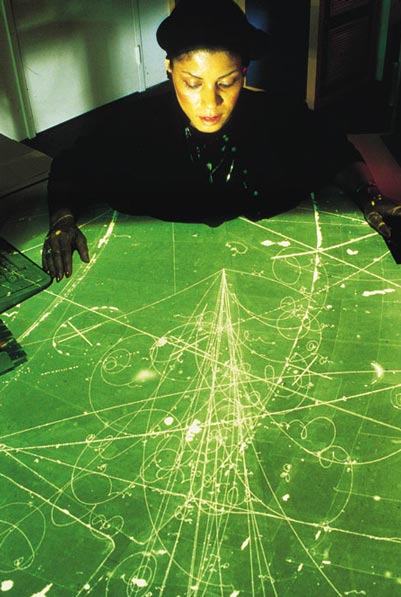
David Parker (Science Source/Photo Researchers, Inc.)
Roughly 200 such particles are now known. Physicists initially separated them into two classes according to their mass: Mesons (from the Greek μεσο, meaning "medium") weigh more than an electron but less than a proton; baryons (βαριο, "heavy") weigh as much or more than a proton. The modern division depends not on mass but on the spin of the particle. Mesons carry integer spin, and baryons carry half-integer spin, measured in units of Planck's constant, h, divided by 2π. (The closest analogue to this purely quantum mechanical quantity would be the speed of a spinning top.)
Together the mesons and baryons are called "hadrons" (which comes from αδρος, "strong"), because these particles all feel the strong force, which along with the electromagnetic force, the weak force and gravity constitute the four basic forces of nature. The first indication for the strong force came in the 1930s when it became obvious that the nuclei of atoms contain tight groups of protons and neutrons. This fact was difficult to understand, because the mutual electrostatic repulsion of the positively charged protons should cause nuclei to fly apart. Physicists soon decided that another fundamental force was needed, one that must act over just a short range, because it had never been detected outside the nucleus.
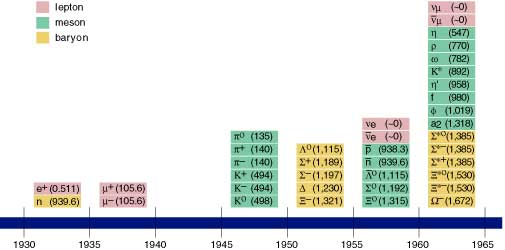
So it was clear enough early on that the strong force exists and that hadrons all feel the strong force. But why were scores of hadrons cluttering the formerly tidy subatomic world? That puzzle remained unsolved until 1961 when Murray Gell-Mann (then a professor at the California Institute of Technology) and Yuval Ne'eman (then an Israeli military attach? in London who was also studying physics at Imperial College) independently proposed the solution. Each realized that the known subatomic particles could be grouped according to a certain mathematical symmetry, which Gell-Mann called the eightfold way, in reference to the Buddhist "eightfold path" to enlightenment.
Support mounted surprisingly swiftly. Just a few months after conceiving the new theory, Gell-Mann attended a conference at CERN, the European particle physics laboratory in Geneva, and was in the audience when a group from the University of California, Los Angeles announced the discovery of two new baryons, Ξ*? (xi-star-minus) and Ξ*0 (xi-star-naught). Gell-Mann realized that this pair nearly completed a group of ten related particles. Not only did he know immediately that another particle in that family had to exist, but he could estimate its properties. Gell-Mann made this bold prediction in front of the assembled physicists, and the race to discover the new particle?called Ω? (omega-minus)?was on. By February 1964 a team at Brookhaven National Laboratory in New York had seen evidence for it. Confirmation arrived from CERN within a few weeks.
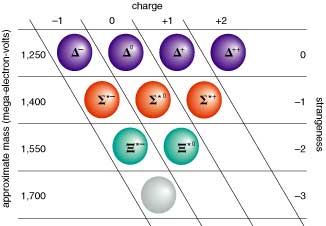
That same year Gell-Mann and George Zweig (who was working at CERN at the time) separately suggested that the symmetry of the known hadrons existed because all are constructed from three fundamental subparticles. Gell-Mann dubbed them quarks, a playful word that he liked, in part, because of the way that James Joyce had used it in Finnegan's Wake ("Three quarks for Muster Mark!").
The proposition was a risky one, because the hypothetical quarks were like no other particles. Quarks were said to come in three varieties, whimsically called "flavors" and named up, down and strange. Like other particles, quarks had a mass and a spin, but unlike all others they carried fractional electric charge. The up had charge +2/3, the down and the strange quarks, ?1/3. The crux of Zweig and Gell-Mann's idea was that hadrons are bound states of quarks, just as atoms are bound states of electrons, protons and neutrons. For example, a proton was said to consist of two up quarks and one down, making for a total electric charge of 2/3 + 2/3 ? 1/3 = 1. A neutron has two down quarks and one up, making a charge of ?1/3 ?1/3 + 2/3 = 0. Fractional charge was a wild notion, but perhaps the most disturbing aspect of the theory was that no quark had ever been seen?something for which Gell-Mann and Zweig offered no explanation.
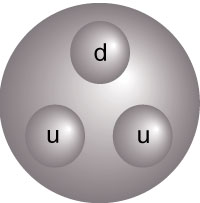
Nonetheless, quark theory gained support. It got a big boost just four years later, when investigators at the Stanford Linear Accelerator Center showed definitively that protons have substructure. Those results came from what was essentially a modern rendition of experiments Ernest Rutherford and Ernest Marsden performed in 1909. At the time, Rutherford and Marsden were shooting alpha particles through thin sheets of mica. What they found was that the particles were only slightly affected the vast majority of the times they penetrated the material. On rare occasions, however, an alpha particle would carom off at a large angle. Rutherford was thunderstruck and declared "It was as though you had fired a 15-inch shell at a piece of tissue paper and it had bounced back and hit you." He soon realized that the bizarre behavior implied that atoms have small but massive cores?that is, he had discovered the nucleus.
In the Stanford experiments of 1968, physicists were scattering electrons off protons when they observed that a small but significant fraction of the electrons made large deflections?revealing the substructure of protons and, by extension, other hadrons. Further probing provided evidence that the subparticles carried fractional charge.
These discoveries mark a watershed. Before that time, many physicists (including Gell-Mann) believed that quarks were merely a mathematical contrivance that helped to systematize the hadronic world. Now it was starting to look as though quarks might exist after all. Finally, in 1974, even the most recalcitrant were won over by the announcement that a new particle had been discovered. This particle, a meson, was made of a fourth flavor of quark, called charm. (Since then two more flavors have been added to the menu: bottom, in 1976, and top, in 1995. Each of these six quarks has a corresponding "antiquark," bringing the total to 12.)
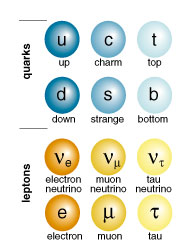
Although the quark hypothesis was enjoying a brilliant success, there were several lingering worries. For one thing, no one had ever seen an isolated quark. A more nagging problem was that the measured properties of a baryon called the Δ++ (delta-plus-plus) seemed to disagree with a general theorem of quantum field theory. That theorem states that the quantum-mechanical wavefunctions that describe hadrons must be antisymmetric if the constituent subparticles are identical. The Δ++ was known to consist of three identical up quarks, yet its observed properties pointed to a wavefunction that was symmetric.
Theorists went to great lengths to resolve the conundrum. Oscar Greenberg of the University of Maryland offered one of the more creative solutions. He proposed that quarks carry a new type of charge that forms itself into an antisymmetric wavefunction. Greenberg's mathematical legerdemain skirted the problem, in essence by declaring that the total wavefunction of the Δ++ was antisymmetric after all; physicists had just missed counting some of it. Gell-Mann dubbed the new attribute color, although it had nothing to do with the usual definition of the word. Such "color charge" presumably came in three varieties, often labeled red, green and blue.
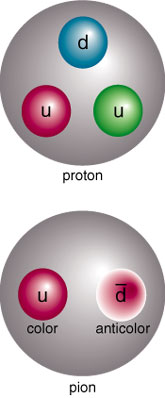
But experimentalists had never observed color. So it seemed that one problem (the symmetry of the Δ++) had just been replaced with another (the absence of color). Yet Greenberg's invention had achieved a certain economy: The inability to observe isolated quarks and the inability to observe color combined to become the "color confinement hypothesis," which states that color is cloistered inside hadrons and can never emerge to interact with any sort of detector. Rather, colors must always aggregate so as to produce a colorless object. Protons, neutrons and other baryons are a combination of three quarks of different colors (red, green and blue), which, like the red, green and blue phosphors of a television screen, combine to produce a colorless mixture. Pions, kaons and other mesons are formed from a quark of a given color and its antiquark made of its "anticolor."
Color confinement proved an important advance because it eventually revealed how quarks stick together. The underlying physics is akin to the attraction between, say, a proton and an electron through the electromagnetic (Coulomb) force. Physicists describe that interaction in terms of the exchange of photons?particles that have no mass or charge but that do have energy and spin. These particles are thus said to be the "carriers" of the electromagnetic force. Indeed, theorists had known for decades that the existence of electrons and protons alone (or, more accurately, their electric charges) is enough to specify the existence and nature of the photon. This magic is accomplished through a mathematical procedure called gauging.
Gauge theory originated with the 1918 work of Hermann Weyl, who attempted to unify gravity and electromagnetism by requiring that physics not depend on the local calibration (or gauge) of spacetime. Although his theory proved wrong, the concept of requiring a local invariance has survived. The first success for gauging came during the 1940s, when it was applied to the quantum theory of electromagnetism, called quantum electrodynamics, or QED for short. The idea was subsequently extended in the 1960s to unify the electromagnetic and weak forces, and it forms the basis of the modern understanding of both the electro-weak and strong forces and the particles they affect, an all-encompassing theory of matter known as the Standard Model.
Clearly, a force-carrying particle analogous to the photon had to exist for quarks?after all, something had to convey the strong force. But what was it? Gell-Mann and Harold Fritzsch of the University of Munich were the first to glimpse the answer after carrying out the gauging procedure for the strong interaction in 1972. They called the resulting theory quantum chromodynamics (QCD), emphasizing its parallel development with quantum electrodynamics and the importance of the color concept. Their work revealed that there had to be eight force carriers, now called gluons, linking quarks together. Gluons are similar to photons in that they are massless and have spin. However they differ from photons in a crucial way: Gluons carry color charge. As a result, gluons, unlike photons, can directly interact with one another?a key property.
QCD may be thought of as a recipe for muffins. Quarks and gluons constitute the ingredients, quantum field theory provides the instructions, and the goods that emerge are the hadrons. Curiously, QCD indicates that the structure of the underlying vacuum in which all particles reside also matters greatly. Thinking of the vacuum as complete nothingness doubtlessly makes this statement confusing. But at the quantum level, the vacuum is not really empty. Indeed, it is a roiling stew worthy of Hecate's witches, with virtual particles zipping in and out of existence so quickly that conservation laws are not violated. All of this virtual activity has a dramatic effect on the force between quarks. Recall that this force is created by the exchange of gluons and that these gluons must penetrate the intervening vacuum. Imagine that gluons find it easiest to follow a blazed trail. The result would be a localization of the gluons into a narrow path between the quarks.
Practitioners of QCD like to make a different analogy, one that relies on the concept of electric or magnetic flux lines. Normally such flux lines spread out to form a pattern familiar to all grade school students who have shaken iron filings over a bar magnet. But in QCD, the structure of the vacuum causes an attraction between the so-called chromomagnetic flux lines so that they collapse together, forming a slender tube.
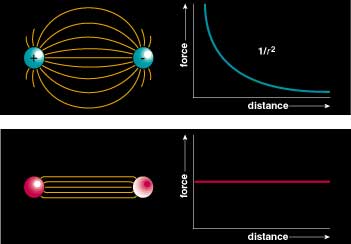
In the case of the electric field, the spreading of flux lines leads to the familiar Coulomb force, which is inversely proportional to the square of the distance from the charge. For mesons, the collapse of chromomagnetic flux into a thin tube gives rise to a dramatically different relation, in which the force retains a constant value called the string tension?as if the flux tube were an elastic band that always exerted the same pull no matter how far it was stretched.
The string tension between a quark and its antiquark corresponds to a very strong binding force: equivalent to the weight of 16 metric tons. Still, one might think that such a force could be overcome and that the two could be separated. What happens in practice is that pulling them apart ever so slightly (about the diameter of a proton) pumps enough energy into the system to break the flux tube in the middle and to spawn a quark and an antiquark, which are attached to the newly created ends. This process generates two color-neutral particles where there had originally been only one. It is in this sense that color always remains locked up.
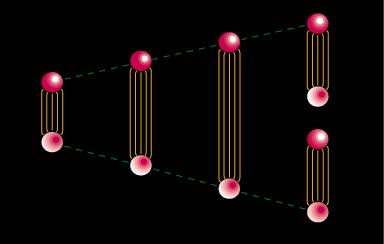
The peculiar nature of the QCD vacuum thus accounts for color confinement. It also helps to explain another curious phenomenon: mass generation. Physicists now think that quarks are in fact much too light to add up to the mass of the particles they form. So it would seem that the simple description of hadrons as a collection of two or three quarks is overly naive. In fact, quantum field theory allows for the number and type of particles that make up a hadron to vary with time. These fluctuations take the form of additional gluons or virtual quark-antiquark pairs, which theorists believe provide the additional heft (some 98 percent of the total) necessary to build up a typical hadron.
Gluons thus help account for the mass of hadrons. But are they always restricted to the interior of these particles, or can they escape and fly through space just as their free-spirited photonic cousins can? Propagating photons certainly exist: You are using them to read this page. Yet confinement implies that color can never be seen?and gluons have color.
Fritzsch and Peter Minkowski of the University of Bern addressed this question in 1975. Their answer was that gluons could clump together to form color-neutral hadrons of purely gluonic matter. These entities, subsequently dubbed glueballs, comprise an entirely new and unexpected class of matter. The electromagnetic analogue would be a clustering of photons?an atom of pure light. Ted Barnes, then a graduate student at Caltech, extended this idea in 1977, when he realized that gluons could also combine with quarks and antiquarks to form hybrid mesons. Together these hybrids and glueballs are called QCD exotics.
What does it take to find an exotic particle? For one thing, theoreticians must have some idea of its properties?its mass, lifetime and modes of decay (that is, the ways in which it winks out of existence, producing lighter long-lived particles in its place). And investigators must be keenly aware of three important quantum numbers that describe the particle they are after. The first number (J) denotes the total spin, the second (P) refers to parity and the third (C) to charge conjugation.
The quantum number J is determined, in part, by how the spins of the constituent quarks line up. In two-quark mesons, the sum of the spins from each component can take on only two values: 1 if the two spins are parallel and 0 if they are antiparallel. The total spin, however, also depends on the relative angular momentum of the two quarks as they move about each other. So J can, in fact, have an integer value higher than 1.
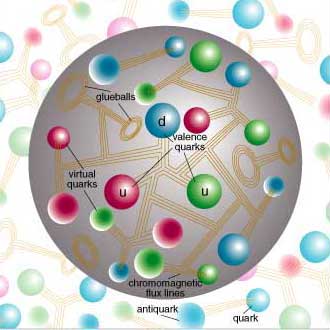
Parity and charge conjugation are more subtle qualities. They describe the symmetry of the quark-antiquark pair under mirror inversion (for parity) and particle-antiparticle interchange (charge conjugation). If the quantum-mechanical wavefunction is unaltered after one of these operations, the particle is said to be symmetric, and the relevant quantum "number" is assigned a plus symbol; if not, it is antisymmetric and given a minus symbol.
The basic rules of quantum mechanics dictate that a meson can have only certain combinations of J, P and C, a tag for the particle that is normally denoted JPC. But quantum chromodynamics makes things more complicated. Recall the picture of a meson as two quarks being held together by a tube of flux that acts somewhat like an elastic band. If one could somehow grab hold of the two quarks and pluck the band between them, it would vibrate like a guitar string. And just as with the plucking of such a string, the flux between quarks can be excited in different ways?each corresponding to a unique kind of hybrid meson.
If the two quarks have their spins aligned, for example, and the motion of the flux tube corresponds to the first excited state (something akin to the fundamental frequency of the guitar string), JPC can be, for instance, 0+? or 1?+, values that just the two quarks themselves cannot produce. Such combinations are, in fact, the signature of a new type of particle, a "hybrid" meson. Whereas the properties of an ordinary meson can be explained by the spins and angular momentum of its quark and antiquark, a hybrid meson manifests the effects of its excited flux tube. Indeed, an excited flux tube is substantial enough to make up a meson without any quarks present. These lone tubes, wrapped into closed rings, are the glueballs, made of nothing but the stuff that holds matter together.
Can such curious particles really exist? They can indeed, but not for long. The vast majority of mesons produced in particle collisions decay almost as soon as they are created, enduring for a mere 10?23 seconds or so. Even if they are traveling at nearly the speed of light, the distance these particles move from birth to death is no longer than the diameter of a proton. So physicists must infer their fleeting existence from the debris they leave behind. In most cases the telltale signs are other mesons with much lower mass and more extended lifetimes, long enough that they leave a discernable trail.
For many years, physicists studied the trajectory of such particles using bubble chambers, vats of liquid hydrogen kept under high pressure. At the instant that the particles impinge on the chamber, a piston is withdrawn, releasing the pressure suddenly. This maneuver lowers the boiling point, but the hydrogen does not vaporize immediately. For a few moments it remains as a precariously "superheated" liquid. Because a particle carrying electric charge gives up energy as it passes through, the superheated hydrogen starts to boil along the path of the speeding charge, and tiny bubbles mark its trajectory. If the chamber is subjected to a vertical magnetic field, the charged particle veers sideways, and the curvature of its trail, which is captured photographically, reveals its momentum. Tracking the directions of all the various decay products?typically, mesons of known mass?thus allows physicists to work out the properties (mass and JPC) of the ephemeral particle that created them.
Bubble chambers have the virtue that they record such events rather fully and without bias, but scanning cluttered images of thousands of tiny bubble trails demands a great deal of labor, and only the more common mesons could be discovered in this way. So starting about 30 years ago, electronic "wire chambers" came into vogue. These devices consist of a volume of gas crisscrossed with high-voltage wires. The passage of a charged particle ionizes the gas along its path, electrically connecting some of the wires together. The pattern of temporary short circuits thus shows the trajectory of the particle. Another kind of electronic detector, called a calorimeter, can measure its energy. The combined arrangement, placed within a magnetic field, is called a spectrometer. Modern spectrometers can gather millions of measurements of passing particles and so are quite valuable in the search for rare mesons. Unlike bubble chambers, however, they do not sample all directions with the same degree of sensitivity.
To compensate, physicists use so-called Monte Carlo techniques, whereby their computers simulate a vast number of random particle collisions, ones that are required only to satisfy the laws of conservation of energy and momentum. The software then calculates the response of the spectrometer to this synthetic barrage. Because modern detectors have a built-in bias, not all of the particle trajectories are detected in the simulations. But by knowing just what is missed, physicists can correct the data obtained during real experiments. This step must be done carefully in the search for exotic mesons, because the assignment of JPC depends on knowing the directions of all the decay products. If the bias corrections are applied incorrectly, an exotic JPC signal may appear when none really exists.
The first serious program to find glueballs was proposed by Claude Amsler of CERN. In 1985 he convinced some of his colleagues to build a detector called the "Crystal Barrel" (a cylindrical device packed with crystalline calorimeters) and attach it to the low-energy antiproton ring they were operating. The idea was to slam protons and antiprotons together and to search for glueballs, which several theorists believed would be created in the aftermath.
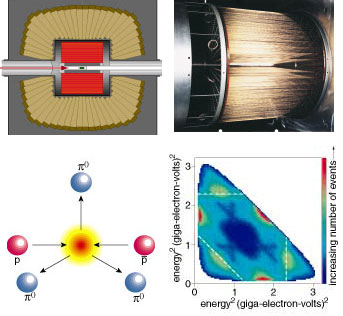
The detector was completed and started to take measurements in December of 1989. The first set of results uncovered a particle that decayed into two neutral pions?a particle that had never been observed before. By April of 1990, the Crystal Barrel detector had recorded about 35,000 such events?an enormous set of measurements.
A group headed by Eberhard Klempt, then at the University of Mainz, spearheaded the analysis of this reaction. By July of that year, the Crystal Barrel physicists began cautiously presenting their results, which they interpreted as a new meson that carried two units of spin. Two years later, David Bugg of Queen Mary and Westfield College and Peter Blum of the University of Karlsruhe (both members of the collaboration) independently looked at the observations again and argued that two new particles of spin 0 could better explain the measurements. By 1994, after studying many more data, the Crystal Barrel investigators concluded that a combination of the two solutions was correct. But the most exciting particle was one with spin 0, named f0(1500) following a convention that includes the spin and the mass (1,500 mega-electron-volts, more than one and a half times the mass of a proton).
Over the next year, as measurements of this particle continued to accumulate, it became clear that f0(1500) was probably not an ordinary meson. In 1995, Amsler and Frank Close of Rutherfold Appleton Laboratory in England published the first paper claiming that it was, in fact, a glueball. Later that year, Donald Weingarten, a theorist at the IBM Watson Research Center in New York, argued that f0(1500) was just a meson: The elusive glueball, in his estimation, should be heavier. He suggested that a curious particle that had been known for more than a decade, the fJ(1710), might well be a glueball. Many physicists now believe that both these particles represent a quantum-mechanical mixture of a glueball and two mesons.
The Crystal Barrel experiment continued to collect measurements until the low-energy antiproton ring at CERN was shut off at the end of 1996. Those efforts in Geneva were, however, not all that was going on in the hunt for exotic particles. In the mid-1980s, Yuri Prokoshkin and a group of Russian colleagues claimed to have found a new particle that decayed into four photons?the very first sighting of an exotic hybrid. The detectors they set up at CERN and at the Institute for High-Energy Physics in Protvino (a small "company town" near Moscow built around a particle accelerator) consisted of blocks of lead glass designed to measure the energy of photons that came from the decay of mesons. These Russian investigators made no attempt to detect charged particles, looking only for photons. They had demonstrated that this technique correctly identified certain well-established mesons. Still, their reports of an exotic meson were met with skepticism, because of some inconsistencies in the complex analysis involved.
In the early 1990s, one of us (Dzierba) joined with Suh Urk Chung of Brookhaven National Laboratory to test the Russian result. We began by forming a collaboration to make improvements on a charged-particle detector at Brookhaven called the multiparticle spectrometer, a large magnet with several wire chambers attached. And members of Dzierba's group at Indiana University joined forces with a different team from Protvino, one headed by Sergei Denisov, to build a photon detector using 3,000 blocks of lead glass.
If Prokoshkin's squad had indeed discovered an exotic, it should be evident from the decay patterns of charged particles as well as from photons. With the multiparticle spectrometer and 11 metric tons of lead glass, the Brookhaven equipment would be sensitive to both. The first tests took place in 1993, and two data runs were completed in 1994 and 1995. Our initial attempt to find the telltale four-photon decay did not succeed. But a negative result came as little surprise: By that time, most of the community had lost confidence in the original sighting, because a reanalysis of the Russian measurements refuted the earlier findings. Other reports of the same exotic meson were ultimately seen as mistaken identifications as well. At the root of the problem was an incomplete understanding of the apparatus, which led people to interpret a small fraction of the decays of an abundant normal meson as the signature for a rare exotic hybrid.
In the meantime, members of the Brookhaven collaboration were analyzing another possible mode of decay (into two photons and a charged pion), using the measurements collected in 1994, and inferred the existence of an exotic hybrid with the same properties (mass and JPC) as the original Russian claim. In fact, yet another group from Protvino had observed that same decay mode but had stopped short of claiming the discovery of an exotic meson. And there was a rumor that physicists working with the Crystal Barrel detector had seen hints of a similar particle.
Within the Brookhaven collaboration there followed intense debate. Most were convinced that they had discovered an exotic meson and wanted to publish a report on it promptly. But those of us from Indiana University were reluctant to make such a claim, at least not until observations from both experimental runs were analyzed. Nonetheless, the majority involved decided to push ahead with an announcement in Physical Review Letters of a new hybrid particle with a mass of 1,400 mega-electron-volts. Shortly thereafter the CERN group published confirming evidence for that particle, named π1(1400).
The controversy indeed caused some bitter feelings within the collaboration. But not too long afterward, everyone came together to announce the discovery of yet another exotic, one with a very different mode of decay and a larger mass. The analysis of this particle, called rho(^)(1600), was not subject to the same problems that could have given rise to a false detection of the lighter hybrid. And the heavier particle was also confirmed in an independent experiment. Still, there remains a problem, because the masses of both mesons fall below what some theorists believe is needed for the lightest exotic hybrid (1,900 mega-electron-volts). Also, in both cases, the observed modes of decay are not what the theorists would have predicted beforehand.
The three of us are working with other experimentalists and theorists (so far about 80 people from 25 institutions in seven countries) to use beams of photons to generate exotic mesons. Why photons? For one, there is very little known about the mesons that high-energy photons can produce. More importantly, QCD theory indicates that such beams should be ideal for creating exotic particles: Quantum mechanically, the photon has a high probability of briefly acting like a virtual quark and antiquark with their spins aligned. Nathan Isgur (then at the University of Toronto) and Jack Paton (University of Oxford) suggested that the flux connecting them can be excited?the string plucked?by collision with a fixed target. This reaction should easily create particles with an exotic value of JPC, the smoking gun in the search for hybrid mesons.
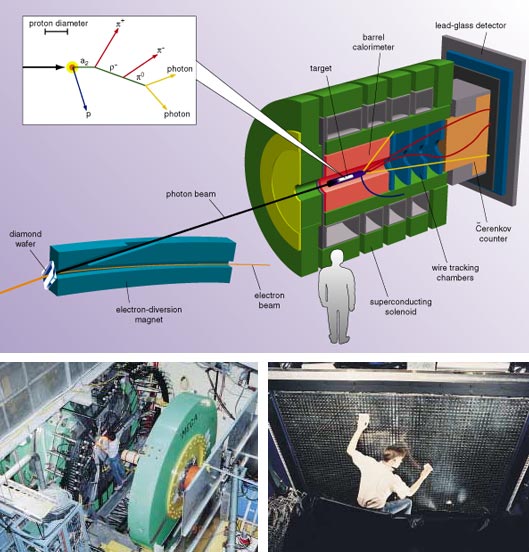
We will be carrying out this experiment at the Thomas Jefferson National Accelerator Facility in Newport News, Virginia, where a large electron accelerator now exists. With some modification, high-energy electrons from this device can be made to produce a beam of suitable photons. The trick is to pass the speeding electrons through a wafer-thin synthetic diamond. As we envision operations, electrons from the accelerator will emerge some 20 feet below ground and slam into the diamond target. Some electrons will be slowed, producing photons by a process called bremsstrahlung, or braking radiation. If things are set up just right, the atoms of the diamond crystal can be made to recoil in step, leading to an enhanced emission at particular energies. This effect (known as coherent bremsstrahlung) has an added bonus: The resulting photons are linearly polarized; that is, their electric fields have a single orientation. This property helps determine the JPC of the mesons produced, whereas the pion beams typically used to generate mesons cannot be polarized.
Although only a fraction of them will produce photons, all the electrons will be swept into the ground. Only photons?about 50 million every second?will reach the target. The detector will consist of a large-aperture superconducting magnet with internal wire chambers and calorimeters as well as a massive lead-glass calorimeter on one end. To keeps costs down, we are recycling: The superconducting magnet, worth about $12 million, was built three decades ago for an experiment at the Stanford Linear Accelerator Center. It was moved in the mid-1980s to the Los Alamos National Laboratory for another study and will soon be transferred to Jefferson Lab for this project. The lead-glass calorimeter was originally built for the Brookhaven experiment at a cost of $3 million and will be brought to the Jefferson Lab as well. If all goes as planned, the first measurements of exotic hybrid particles will be collected within five to seven years. Despite the savings from reusing equipment, the total price tag will still amount to around $30 million.
Clearly, the scale of this project is huge. Yet our experiment is not the only one in the works. New efforts are planned or taking place now in Geneva, in Novosibirsk and in Beijing. And a completely new laboratory for carrying out these kinds of studies is being designed in Japan. We fully expect that a rich suite of QCD exotics will be discovered and thoroughly studied within the next decade. Only then can particle physicists claim to really comprehend glueballs, hybrids, how hadrons decay, how they interact and how mass is generated. Most importantly, only then can we say that we really understand the standard model of matter.
Click "American Scientist" to access home page
American Scientist Comments and Discussion
To discuss our articles or comment on them, please share them and tag American Scientist on social media platforms. Here are links to our profiles on Twitter, Facebook, and LinkedIn.
If we re-share your post, we will moderate comments/discussion following our comments policy.